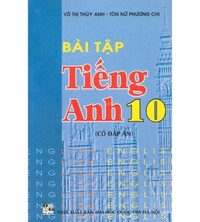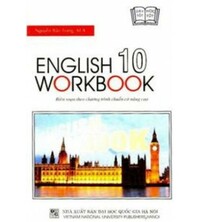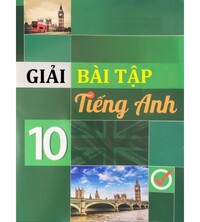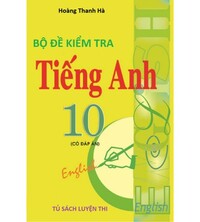Đề thi giữa kì 1 Tiếng Anh 10 Bright - Đề số 1
Mark the letter A, B, C or D on your answer sheet to indicate the word whose underlined part differs from the other three in pronunciation in each of the following questions. Mark the letter A, B, C or D on your answer sheet to indicate the word that differs from the other three in the position of the main stress in each of the following questions. Mark the letter A, B, C or D on your answer sheet to indicate the correct answer to each of the following questions. Mark the letter A, B, C or D on
Đề bài
I. Pronunciation
Mark the letter A, B, C or D on your answer sheet to indicate the word whose underlined part differs from the other three in pronunciation in each of the following questions.
1.
A. vacuum
B. classical
C. amazing
D. actor
2.
A. basic
B. cousin
C. musical
D. museum
Mark the letter A, B, C or D on your answer sheet to indicate the word that differs from the other three in the position of the main stress in each of the following questions.
3.
A. household
B. perform
C. tidy
D. laundry
4.
A. orchestra
B. festival
C. furniture
D. tradition
II. Use of English
Mark the letter A, B, C or D on your answer sheet to indicate the correct answer to each of the following questions.
5. Hey! Why __________ that tablet? It __________ to me.
A. do you use/ belongs
B. are you using/ is belong
C. do you use/ is belong
D. are you using/ belongs
6. As a child, Alice __________ to sing in the choir, but now she plays volleyball instead.
A. would
B. used
C. could
D. likes
7. Johann really enjoyed the __________ of eighteenth-century art at the City gallery.
A. exhibition
B. demonstration
C. concert
D. dance performance
8. I usually __________ a nap after lunch. It helps me to reduce sleepiness and work effectively in the afternoon.
A. do
B. make
C. take
D. bring
9. The sink was full of dirty dishes, so I __________.
A. set the table
B. mopped the floor
C. cleared the dishwasher
D. did the washing-up
10. I’m preparing for the party tomorrow. Can you help me __________ the decorations?
A. put up
B. put on
C. put in
D. put out
11. My mum __________ the floor using soap and water twice a week.
A. vacuums
B. mops
C. dusts
D. makes
12. I enjoy watching __________ because they bring me great laughter.
A. operas
B. ballets
C. tragedies
D. comedies
13. During the __________, the audience clapped at the end of every single song.
A. musical
B. drama
C. orchestra
D. exhibition
14. That play is much better on the __________ than it is in the film version.
A. scene
B. theatre
C. stage
D. performance
Mark the letter A, B, C or D on your answer sheet to indicate the word or phrase that is CLOSEST in meaning to the underlined part in each of the following questions.
15. Mrs. Jones lives on her own and has to take care of her two children, so she’s really busy.
A. look at
B. look after
C. love
D. watch
16. Don’t worry about the exam. You only need to do your best.
A. hope
B. review
C. concentrate
D. try hard
Mark the letter A, B, C or D on your answer sheet to indicate the word or phrase that is OPPOSITE in meaning to the underlined part in each of the following questions.
17. Put on your coat. It’s quite windy.
A. wear
B. bring
C. take off
D. prepare
18. I’m really into classical music. It’s soft and calm. It also helps me relieve stress.
A. peaceful
B. noisy
C. boring
D. cheerful
Mark the letter A, B, C or D on your answer sheet to show the underlined part that needs correction in each of the following questions.
19. My sister is so busy with her studies that she doesn’t have little time to relax.
A. is
B. with
C. little
D. to relax.
20. It was relaxed taking a walk along the river; we were impressed by how beautiful it was.
A. relaxed
B. along
C. impressed
D. how beautiful
Mark the letter A, B, C or D on your answer sheet to indicate the sentence that best completes each of the following exchanges.
21. Student A: “Would you like to come with me to the stadium tomorrow. There’s a football match at 3 p.m.”
Student B: “___________ . What time will we meet?”
A. I’d love to.
B. I’m afraid I can’t.
C. Sure, I would.
D. I like football.
22. Student A: “How much sugar do you want in your coffee?”
Student B: “____________”
A. A lot of.
B. A few, please.
C. Not many.
D. Just a little.
23. Student A: “I lost my wallet during the rock concert last night.”
Student B: “_________”
A. Oh no! How terrible!
B. Hmm! I’m not sure.
C. Really? What do you do?
D. Aha, you shouldn’t go there.
III. Word Formation
Write the correct forms of the words in the brackets.
24. The show ended with all the ________ singing on stage together. (PERFORM)
25. ________, Chèo is performed outdoors in a village square or the courtyard of a public building. (TRADITION)
IV. Reading
Read the following passage and mark the letter A, B, C or D on your answer sheet to indicate the correct word or phrase that best fits each of the numbered blanks from 26 to 30.
Unlike most teenagers who live in flats or houses, Sophia’s home is a 20-metre boat. She has spent half of her life (26. sail/ to sail/ sailing/ sailed) with her parents, who are both marine scientists. Sophia’s unusual way of life means she regularly sees whales and gets to swim with dolphins. She also has friends in different countries. She does her schoolwork online and her studies are going well. She can speak four languages and has been to many countries, so her (27. education/ advice/ knowledge/ information) of the world is greater than most children her age. Every day after studying, she helps do the (28. household/ homework/ housework/ task). She feels she has a duty to help her parents. She believes family life is more pleasant when everyone shares the household chores. She often cleans the floors, (29. makes/ does/ brings/ sets)
the table for meals and does the washing-up. She also cooks dinner, especially when her parents are too busy. Life on board is sometimes (30. convenient/ uncomfortable/ relaxing/ entertaining). Space is limited, so there are no wide-screen TVs or soft sofas. Bad weather can last for days, especially in winter. Storms at sea can be frightening. However, Sophia loves her boat and she feels safe on it.
Read the following passage. For each of the questions from 31 to 35, write T if the statement is TRUE, F if the statement is FALSE and NI if there is NO INFORMATION on it.
MY UNUSUAL HOBBY – SAND SCULPTURES
I live on the coast of Ocean City, Maryland, where there are lots of beautiful sandy beaches and warm sunny days. It’s the perfect place for my favourite hobby – making sand sculptures. Four years ago, there was a sand sculpture festival near where I live. I couldn’t believe that such wonderful model buildings, incredible creatures, and some amazingly realistic faces of celebrities were all made out of sand. From that moment, I knew that this was something I would love to do. I’ve heard people say that making sand castles is for kids, not adults, but that doesn’t bother me at all. I believe sand art is a creative and playful hobby that can be enjoyed by all ages. People can make different kinds of shapes and form structures out of their creative mind. The only materials needed are water and sand – plenty of it, and lots of time. Creating a big sand sculpture may take up to weeks to build. It also requires a lot of endurance and patience from the sculptors. Many people don’t understand that even lightly touching a sand sculpture can make a whole section fall off, which can take hours to rebuild. Of course, heavy rain can do some damage, but not as much as you might think. As long as you build far enough up the beach, the waves won’t wash a sand sculpture away. So, when you’re next at the seaside, make one yourself – you’ll get a great sense of achievement.
31. The writer decided to start making sand sculptures after being impressed by some near her house. true
32. Some people believe that making sand sculptures is only a hobby for children. true
33. You need special equipment in order to make big sand sculptures. false
34. Sculptors may spend a lot of time making a sand sculpture. true
35. Heavy rain or waves can destroy a sand sculpture completely. false
V. Writing
Use the words in brackets to rewrite the following sentences without changing the meaning.
36. Do you have any plans for this weekend? (DOING)
=> What ___________________________?
37. My mum was a guide in a museum when she was young. (WORKED)
=> My mum ________________________.
38. During my visit to the British Museum, I learnt a lot about ancient Egyptian civilisation.
=> While __________________________.
39. All of us are excited about our trip to Canada next month. (LOOKING)
=> Every of us _____________________.
40. Clara didn’t have the habit of going to the cinema when she was young. (USE)
=> Clara __________________________.
---------------------THE END---------------------
Đáp án
HƯỚNG DẪN GIẢI
Thực hiện: Ban chuyên môn

36. are you doing this weekend
37. worked as a guide in a museum when she was young
38. I was visiting the British Museum, I learnt a lot about ancient Egyptian civilisation
39. is looking forward to our trip to Canada next month
40. didn’t use to go to the cinema when she was young
LỜI GIẢI CHI TIẾT
1. C
A. vacuum /ˈvæk.juːm/
B. classical /ˈklæs.ɪ.kəl/
C. amazing /əˈmeɪ.zɪŋ/
D. actor /ˈæk.tɚ/
Phần được gạch chân ở phương án C được phát âm /eɪ/, các phương án còn lại được phát âm /æ/.
Chọn C.
2. A
A. basic /ˈbeɪ.sɪk/
B. cousin /ˈkʌz.ən/
C. musical /ˈmjuː.zɪ.kəl/
D. museum /mjuːˈziː.əm/
Phần được gạch chân ở phương án A được phát âm /s/, các phương án còn lại được phát âm /z/.
Chọn A.
3. B
A. household /ˈhaʊs.hoʊld/
B. perform /pɚˈfɔːrm/
C. tidy /ˈtaɪ.di/
D. laundry /ˈlɑːn.dri/
Phương án B có trọng âm 2, các phương án còn lại có trọng âm 1.
Chọn B.
4. D
A. orchestra /ˈɔːr.kə.strə/
B. festival /ˈfes.tə.vəl/
C. furniture /ˈfɝː.nɪ.tʃɚ/
D. tradition /trəˈdɪʃ.ən/
Phương án D có trọng âm 2, các phương án còn lại có trọng âm 1.
Chọn D.
5. D
- Thì hiện tại tiếp diễn được dùng để diễn tả những sự việc đang xảy ra tại thời điểm đang nói.
Công thức dạng câu hỏi với Wh-word: WH + to be + S + V-ing?
- Chủ ngữ “It” -> động từ thêm “-s”.
Hey! Why are you using that tablet? It belongs to me.
(Này! Sao cậu lại dùng cái máy tính bảng đó? Nó là của tớ mà.)
Chọn D.
6. B
- Nói về một sự việc đã xảy ra và kết thúc trong quá khứ, không còn tiếp tục ở hiện tại nữa:
S + used to + V nguyên thể.
As a child, Alice used to sing in the choir, but now she plays volleyball instead.
(Khi còn bé, Alice đã từng hát trong đội hợp xướng, nhưng hiện tại thì cô ấy chơi bóng rổ.)
Chọn B.
7. A
exhibition (n): buổi triển lãm
demonstration (n): sự minh họa
concert (n): buổi hòa nhạc
dance performance (n): màn trình diễn nhảy
Johann really enjoyed the exhibition of eighteenth-century art at the City gallery.
(Johann đã thực sự thưởng thức buổi triển lãm về những tác phẩm nghệ thuật thế kỉ 18 ở phòng triển lãm thành phố.)
Chọn A.
8. C
Take a nap: chợp mắt (ngủ một giấc ngắn)
I usually take a nap after lunch. It helps me to reduce sleepiness and work effectively in the afternoon.
(Tôi thường chợp mắt sau bữa trưa. Nó giúp tôi giảm thiểu cơn buồn ngủ và làm việc hiệu quả hơn vào buổi chiều.)
Chọn C.
9. D
set the table: dọn bàn (thường là bàn ăn)
mopped the floor: lau sàn
cleared the dishwasher: làm sạch máy rửa bát
did the washing-up: dọn rửa
The sink was full of dirty dishes, so I did the washing-up.
(Trong bồn đầy bát đĩa bẩn, vậy nên tôi đã dọ rửa chúng.)
Chọn D.
10. A
put up (phr.) treo lên
put something on (phr.): mặc cái gì đó lên
put in (phr.): đưa vào
put something out (phr.): thổi tắt, tắt (ánh sáng)
I’m preparing for the party tomorrow. Can you help me put up the decorations?
(Mình đang chuẩn bị cho buổi tiệc ngày mai. Cậu có thể giúp mình treo những món đồ trang trí lên không?)
Chọn A.
11. B
vacuums (v): hút bụi
mops (v): lau
dusts (v): quét bụi
makes (v): làm
My mum mops the floor using soap and water twice a week.
(Mẹ tôi lau sàn với xà phòng và nước 2 lần mỗi tuần.)
Chọn B.
12. D
operas (n): nhạc kịch (số nhiều)
ballets (n): múa ba-lê (số nhiều)
tragedies (n): bi kịch (số nhiều)
comedies (n): phim hài (số nhiều)
I enjoy watching comedies because they bring me great laughter.
(Tôi thích xem phim hài vì chúng làm tôi cười rất nhiều.)
Chọn D.
13. A
musical (n): vở nhạc kịch
drama (n): phim
orchestra (n): dàn nhạc
exhibition (n): buổi triển lãm
During the musical, the audience clapped at the end of every single song.
(Trong suốt vở nhạc kịch, khán giả đã vỗ khi kết thúc mỗi bài hát.)
Chọn A.
14. C
scene (n): cảnh
theatre (n): nhà hát
stage (n): sân khấu
performance (n): màn trình diễn
That play is much better on the stage than it is in the film version.
(Vở kịch đó khi được diễn trên sân khấu hay hơn phiên bản được chuyển thể thành phim rất nhiều.)
Chọn C.
15. B
look at: nhìn vào
take care of = look after: chăm sóc
love (v): yêu
watch (v): xem
Mrs. Jones lives on her own and has to take care of her two children, so she’s really busy.
(Cô Jones sống đơn thân và phải chăm sóc cho 2 đứa con của cô ấy, vậy nên cô rất bận rộn.)
Chọn B.
16. D
hope (v): hi vọng
review (v): ôn tập
concentrate (v) tập trung
try hard = do someone’s best: cố gắng
Don’t worry about the exam. You only need to do your best.
(Đừng lo lắng về kì thi. Cậu chỉ cần thật cố gắng là được.)
Chọn D.
17. C
wear (v): mặc
bring (v): mang, cầm
take off (phr.) cởi ra >< put on (phr.): mặc vào
prepare (v): chuẩn bị
Put on your coat. It’s quite windy
(Mặc áo khoác của bạn vaò. Trời khá là gió đấy.)
Chọn C.
18. B
peaceful (adj): yên bình
noisy (adj): ồn ào >< calm (adj): êm đềm
boring (adj): nhàm chán
cheerful (adj): vui vẻ
I’m really into classical music. It’s soft and calm. It also helps me relieve stress.
(Tôi thực sự rất thích nhạc cổ diển. Nó nhẹ nhàng và êm đềm. Nó cũng giúp tôi giảm căng thẳng nữa.)
Chọn B.
19. C
Giải thích: “doesn’t” đã mang nghĩa phủ định, “little” cũng mang nghĩa phủ định nên không thể cùng được sử dụng trong một câu.
Sửa: bỏ “little”
My sister is so busy with her studies that she doesn’t have time to relax.
(Chị gái tôi rất bận rộn với việc học nên chị ấy không có thời gian để nghỉ ngơi.)
Chọn C.
20. A
Giải thích: “relaxing” là tính từ chủ động được dùng để mô tả đặc điểm của người hoặc vật; “relaxed” là tính từ bị động được dùng để chỉ cảm giác chủ quan. Ở câu này là cảm nhận của người nói về một sự việc khác, không phải về bản thân người nói nên không thể dùng tính từ có đuôi –ed.
Sửa: “relaxed” thành “relaxing”
It was relaxing taking a walk along the river; we were impressed by how beautiful it was.
(Rất thư giãn khi tản bộ dọc bờ sông. Chúng tôi đã bị ấn tượng bởi vè đẹp của nó.)
Chọn A.
21. A
Student A: “Would you like to come with me to the stadium tomorrow? There’s a football match at 3 p.m.”
(Cậu có muốn đến sân vận động cùng mình vào ngày mai không? Có một trận bóng đá lúc 3 giờ chiều.)
Student B: “I’d live to. What time will we meet?”
(Mình thích lắm. Chúng mình sẽ gặp nhau lúc mấy giờ đây?)
Chọn A.
22. D
Student A: “How much sugar do you want in your coffee?”
(Cậu muốn bỏ bao nhiều đường vào cà phê?)
Student B: “Just a little.”
(Một chút thôi.)
Chọn D.
23. A
Student A: “I lost my wallet during the rock concert last night.”
(Mình đã bị mất ví ở buổi hòa nhạc rock vào tối qua.)
Student B: “Oh no! How terrible!”
(Ôi trời. Dã man!)
Chọn A.
24.
Vị trí của từ cần điền là ở sau mạo từ “the”, là chủ thể của hành động “singing” và phải là số nhiều vì có “all” nên nó phải là một danh từ chỉ người số nhiều.
The show ended with all the performers singing on stage together.
(Chương trình kết thúc bằng việc tất các nghệ sĩ hát cùng nhau trên sân khấu.)
Đáp án: performers
25.
Vị trí của từ cần điền là ở đầu câu nên nó cần là một trạng từ.
Traditionally, Chèo is performed outdoors in a village square or the courtyard of a public building.
(Theo truyền thống, Chèo được biểu diễn ngoài trời ở đình làng hoặc sân của một công trình công cộng.)
Đáp án: Traditionally
26.
Câu chủ động sử dụng mệnh đề quan hệ rút gọn => dùng V-ing.
She has spent half of her life sailing with her parents, who are both marine scientists.
(Cô đã dành một nửa cuộc đời để chèo thuyền cùng với cha mẹ mình, cả hai đều là nhà khoa học hàng hải.)
Đáp án: sailing
27.
education (n): sự giáo dục
advice (n): lời khuyên
knowledge (n): kiến thức
information (n): thông tin
She can speak four languages and has been to many countries, so her knowledge of the world is greater than most children her age.
(Cô ấy có thể nói bốn thứ tiếng và đã đến nhiều quốc gia, vì vậy kiến thức về thế giới của cô ấy nhiều hơn hầu hết những đứa trẻ cùng tuổi.)
Đáp án: knowledge
28.
household (n): hộ gia đình
homework (n): bài tập về nhà
housework (n): việc nhà
task (n: nhiệm vụ
Every day after studying, she helps do the housework.
(Mỗi ngày sau giờ học, cô ấy đều giúp làm việc nhà.)
Đáp án: housework
29.
Cụm từ: set the table (bày bàn ăn/ dọn bàn ăn)
She often cleans the floors, sets the table for meals and does the washing-up.
(Cô thường dọn dẹp sàn nhà, dọn bàn ăn và giặt giũ.)
Đáp án: sets
30.
convenient (adj): tiện lợi
uncomfortable (adj): không thoải mái
relaxing (adj): thư giãn
entertaining (adj): mang tính giải trí
Life on board is sometimes uncomfortable.
(Cuộc sống ở trên thuyền đôi khi không dễ chịu cho lắm.)
Đáp án: uncomfortable
Đoạn văn hoàn chỉnh:
Unlike most teenagers who live in flats or houses, Sophia’s home is a 20-metre boat. She has spent half of her life (26) sailing with her parents, who are both marine scientists. Sophia’s unusual way of life means she regularly sees whales and gets to swim with dolphins. She also has friends in different countries. She does her schoolwork online and her studies are going well. She can speak four languages and has been to many countries, so her (27) knowledge of the world is greater than most children her age. Every day after studying, she helps do the (28) housework. She feels she has a duty to help her parents. She believes family life is more pleasant when everyone shares the household chores. She often cleans the floors, (29) sets the table for meals and does the washing-up. She also cooks dinner, especially when her parents are too busy. Life on board is sometimes (30) uncomfortable. Space is limited, so there are no wide-screen TVs or soft sofas. Bad weather can last for days, especially in winter. Storms at sea can be frightening. However, Sophia loves her boat and she feels safe on it.
Tạm dịch:
Không giống như hầu hết thanh thiếu niên sống trong một căn hộ hoặc một ngôi nhà, nhà của Sophia là một chiếc thuyền dài 20 mét. Cô đã dành một nửa cuộc đời để chèo thuyền cùng với cha mẹ mình, cả hai đều là nhà khoa học biển. Điều khác biệt trong cuộc sống của Sophia đó cô thường xuyên nhìn thấy cá voi và bơi cùng cá heo. Cô bé cũng có bạn bè ở các quốc gia khác nhau. Cô ấy làm bài tập ở trường trực tuyến và việc học của cô ấy đang tiến triển tốt. Cô ấy có thể nói bốn ngôn ngữ và đã cũng đến nhiều quốc gia, vì vậy kiến thức về thế giới của cô ấy nhiều hơn hầu hết những bạn cùng tuổi. Mỗi ngày sau giờ học, cô ấy đều giúp làm việc nhà. Cô cảm thấy mình có bổn phận cần phải giúp đỡ bố mẹ. Cô tin rằng cuộc sống gia đình sẽ dễ chịu hơn khi mọi người cùng nhau chia sẻ công việc nhà. Cô thường dọn lau sàn, dọn bàn ăn và giặt giũ. Cô ấy cũng nấu được bữa tối, đặc biệt là khi bố mẹ cô ấy quá bận rộn. Cuộc sống trên tàu đôi khi không thoải mái cho lắm. Không gian có hạn nên không có TV màn hình rộng hay ghế sofa êm ái. Thời tiết xấu có thể kéo dài nhiều ngày, đặc biệt là vào mùa đông. Bão trên biển có thể khá đáng sợ. Tuy nhiên, Sophia yêu con thuyền của mình và cô ấy cảm thấy an toàn ở trên nó.
Tạm dịch bài đọc;
SỞ THÍCH LẠ LÙNG CỦA TÔI - ĐIÊU KHẮC CÁT
Tôi sống trên bờ biển của Ocean City, Maryland, nơi có rất nhiều bãi cát đẹp và những ngày nắng ấm. Đó là một nơi hoàn hảo cho sở thích của tôi - tạo ra những tác phẩm điêu khắc bằng cát. Bốn năm trước, có một lễ hội điêu khắc cát gần nơi tôi sống. Tôi không thể tin được rằng những tòa nhà mô hình tuyệt vời như vậy, những sinh vật đáng kinh ngạc và những khuôn mặt trông giống thật đến kinh ngạc của những người nổi tiếng đều được làm từ cát. Từ thời điểm đó, tôi biết rằng đây là điều mà tôi rất thích làm. Tôi nghe người ta nói rằng làm lâu đài cát là thứ chỉ dành cho trẻ em chứ không phải người lớn, nhưng điều đó không khiến tôi bận tâm chút nào. Tôi tin rằng nghệ thuật làm cát là một thú vui sáng tạo và thú vị có thể được yêu thích bởi mọi lứa tuổi. Người ta có thể làm ra các loại hình dạng và cấu trúc khác nhau từ sự sáng tạo của họ. Nguyên liệu duy nhất cần thiết là nước và cát – số lượng rất nhiều, và rất nhiều thời gian. Việc tạo ra một tác phẩm điêu khắc trên cát lớn có thể mất đến hàng tuần để tạo dựng. Nó cũng đòi hỏi rất nhiều sự bền bỉ và kiên nhẫn của các nghệ nhân điêu khắc. Nhiều người không hiểu rằng ngay cả khi chạm nhẹ vào một tác phẩm điêu khắc bằng cát cũng có thể khiến cả một bộ phận rơi ra và có thể mất hàng giờ để làm lại. Tất nhiên, mưa lớn có thể gây ra một số thiệt hại, nhưng không nhiều như bạn nghĩ. Miễn là bạn xây đủ xa bãi biển, sóng sẽ không cuốn trôi tác phẩm điêu khắc trên cát. Vì vậy, khi bạn đến bờ biển tiếp theo, hãy tự mình tạo ra một tác phẩm - bạn sẽ có được cảm thành tựu rất tuyệt vời.
31. T
The writer decided to start making sand sculptures after being impressed by some near her house.
(Tác giả quyết định bắt đầu làm những tác phẩm điêu khắc bằng cát sau khi bị ấn tượng bởi một số tác phẩm gần nhà cô ấy.)
Thông tin: Four years ago, there was a sand sculpture festival near where I live.
(Bốn năm trước, có một lễ hội điêu khắc cát gần nơi tôi sống.)
Chọn T.
32. T
Some people believe that making sand sculptures is only a hobby for children.
(Một số người cho rằng làm tượng cát chỉ là sở thích của trẻ em.)
Thông tin: I’ve heard people say that making sand castles is for kids, not adults...
(Tôi nghe người ta nói rằng làm lâu đài cát là thứ chỉ dành cho trẻ em chứ không phải người lớn...)
Chọn T.
33. NI
You need special equipment in order to make big sand sculptures.
(Bạn cần một số dụng cụ đặc biệt để làm ra những bức tượng cát lớn.)
Chọn NI.
34. T
Sculptors may spend a lot of time making a sand sculpture.
(Các nhà điêu khắc có thể phải mất rất thời gian để tạo ra một tác phẩm điêu khắc trên cát.)
Thông tin: The only materials needed are water and sand – plenty of it, and lots of time. Creating a big sand sculpture may take up to weeks to build.
(Nguyên liệu duy nhất cần thiết là nước và cát – số lượng rất nhiều, và rất nhiều thời gian. Việc tạo ra một tác phẩm điêu khắc trên cát lớn có thể mất đến hàng tuần để tạo dựng.)
Chọn T.
35. F
Heavy rain or waves can destroy a sand sculpture completely.
(Mưa lớn hoặc những con sóng có thể phá hủy hoàn toàn một bức tượng bằng cát.)
Thông tin: ...heavy rain can do some damage, but not as much as you might think. As long as you build far enough up the beach, the waves won’t wash a sand sculpture away.
(...mưa lớn có thể gây ra một số thiệt hại, nhưng không nhiều như bạn nghĩ. Miễn là bạn xây đủ xa bãi biển, sóng sẽ không cuốn trôi tác phẩm điêu khắc trên cát.)
Chọn F.
36.
Do you have any plans for this weekend?
(Bạn có kế hoạch gì vào cuối tuần này không?)
Giải thích: thì hiện tại tiếp diễn mang nghĩa tương lai dùng để diễn tả những sự việc đã được lên kế hoạch trong tương lai.
=> What are you doing this weekend?
(Bạn sẽ làm gì vào cuối tuần này?)
Đáp án: are you doing this weekend
37.
My mum was a guide in a museum when she was young.
(Mẹ tôi là một người hướng dẫn ở bảo tàng khi bà còn trẻ.)
Câu trúc: S + was/were + a/an + N (nghề nghiệp) = S + worked as + a/an + N (nghề nghiệp)
=> My mum worked as a guide in a museum when she was young.
(Mẹ tôi đã từng làm việc như một người hướng dẫn ở bảo tàng khi bà còn trẻ.)
Đáp án: worked as a guide in a museum when she was young
38.
During my visit to the British Museum, I learnt a lot about ancient Egyptian civilisation.
(Trong suốt chuyến thăm của tôi ở bảo tàng Anh, tôi đã học được rất nhiều về sự khai hóa của nền văn minh Ai Cập cổ đại.)
Giải thích: Nói về một sự việc đang xảy ra thì một sự việc khác xen vào trong quá khứ:
Cấu trúc: While + S + was/were + V-ing, S + V quá khứ đơn.
=> While I was visiting the British Museum, I learnt a lot about ancient Egyptian civilisation.
(Khi đang tham quan viện bảo tàng Anh, tôi đã học được rất nhiều về sự khai hóa của nền văn minh Ai Cập cổ đại.)
Đáp án: I was visiting the British Museum, I learnt a lot about ancient Egyptian civilisation.
39.
All of us are excited about our trip to Canada next month.
(Tất cả chúng tôi đều rất hào hứng về chuyến đi đến Canada tháng sau.)
Cấu trúc: be excited about something = be looking forward to something: háo hức, mong chờ đến cái gì
=> Every of us is looking forward to our trip to Canada next month.
(Tất cả chúng tôi đều rất mong chờ đến chuyến đi tới Canada tháng sau.)
Đáp án: is looking forward to our trip to Canada next month
40.
Clara didn’t have the habit of going to the cinema when she was young.
(Clara không có thói quen đi đến rạp chiếu phim khi cô ấy còn trẻ.)
Cấu trúc: not have the habit of doing something = not use to do something: không có thói quen, không quen làm gì.
=> Clara didn’t use to go to the cinema when she was young.
(Clara không quen đi đến rạp chiếu phim khi cô ấy còn trẻ.)
Đáp án: didn’t use to go to the cinema when she was young
Search google: "từ khóa + timdapan.com" Ví dụ: "Đề thi giữa kì 1 Tiếng Anh 10 Bright - Đề số 1 timdapan.com"







